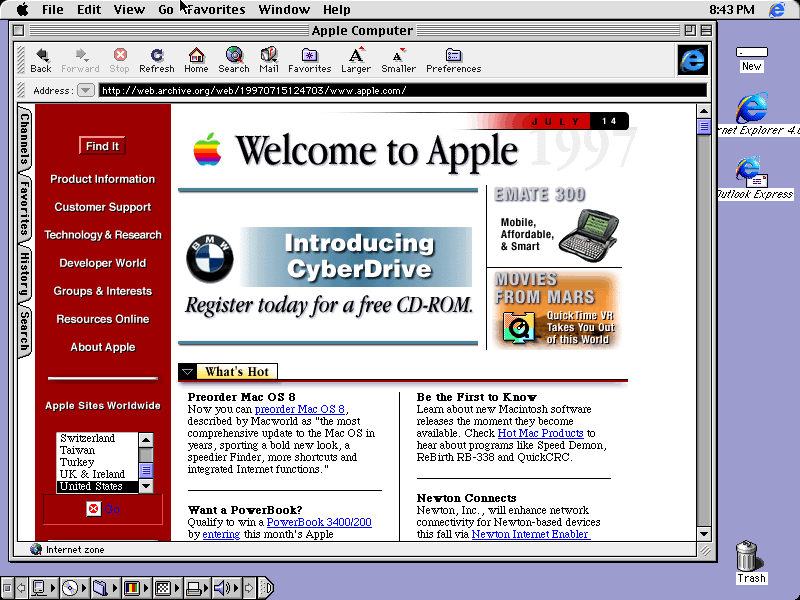This article was first published on August 5, 1997, shortly after Mac
OS 8 was released. The strongest memory I have of attending the Mac
OS 8 event was sitting there, as someone who had both a Windows 95
PC and a Motorola StarMax Mac-clone
(running OS 7.5.3 or OS 7.6 I think), and feeling - over and over -
that OS 8 was playing catch up with Windows 95. The article
mentions context menus, but that wasn't all - improvements to desktop
wallpaper, easier Internet access, and more all felt like Apple's
response to the success of Windows 95.
While Windows 95 was widely viewed as making PC's "more Mac-like",
in copying Apple, Microsoft also pushed the GUI-envelope. At Apple's
2006 WWDC keynote, banners festooned the hall famously reading
"Redmond, start your photocopiers." And certainly, Microsoft has never
restrained itself from copying features introduced by others -
right-click/contextual menus first appeared in Windows
applications developed by Lotus; Microsoft made the feature system-wide
in Windows 95. And lots and lots of Windows features appeared first on
the Mac.
But that long-ago OS 8 launch event reminded me that Apple, too, can
copy features - in some cases from third-party developers, but even
from arch-rival Microsoft.
Apple's New OS 8 System Falls Short of Revolution but Is Still a
Step Forward for Clan Macintosh
Aug 5, 1997
Despite the chaos and uncertainty at Apple caused by the surprise
departure of CEO Gil
Amelio and head of technology Ellen Hancock, the company is moving
ahead with plans to update the Macintosh operating system - a platform
known for its ease of use but saddled with decade-old roots.
Those aging roots have forced Mac users to put up with a system that
crashes more often than they would like and that lacks some of the
features available to users of rival Windows systems, including stable
multitasking.
Having purchased Steve
Jobs' NeXT Corp. to gain access to its operating system, Apple
developers are busy trying to integrate the two technologies. The
project, code-named Rhapsody, won't be available to users until some
time next year, at the earliest.
In the meantime, owners of fairly recent Macintoshes will be offered
an interim product, OS 8 (formerly
code-named Tempo), to replace the current, five-year-old System 7 generation of operating
systems.
With an expected release later this summer, Apple has been
demonstrating its features. I saw OS 8 in action at a seminar held
recently at Denman Street's Electric Zoo. And while OS 8 isn't a
revolution, it looks like a useful step forward for Mac users.
A number of new features will save trips to the menu bar. For
example, many objects offer contextual menus,
meaning you can command-click on an icon, a window, or even text, and a
menu pops up with the actions most usefully performed on that object.
(Application software will need to be rewritten to take advantage of
this handy feature.)
A new File Menu item lets you send an object to the Trash, even if
the Trash icon is hidden. And dragging while pressing the Command and
Option keys automatically creates an Alias.
Desktop clutter is addressed with new button and tab views of icons
and windows. The buttons can be launched with a single click, while
tabs minimize the amount of space taken by these objects but easily
open up when needed to display their contents.

Mac OS 8 screen shot with Internet Explorer 4.0.
Users get a modernized, 3-D look, which is more easily customized
through a redesigned control panel.
An Internet Setup Assistant simplifies creating an account with an
Internet service provider. The control panel adds a Connect To
item, which allows direct connection to an Internet address at any
time, regardless of what application is loaded. The Web Sharing Control
Panel makes it easy to publish data on the Net.
Perhaps the most welcome improvements, however, are under the hood.
The Mac Finder has been rewritten to take fuller advantage of PowerPC
power. That means most Finder operations will feel perkier. As well,
the Finder is now multithreaded, which means that multiple tasks can be
performed at the same time, so you can start to copy a large number of
files but keep working while the copying takes place, for example.
(Formatting a disk, however, still shuts everything else down.)
Many of these features have been available as separate utilities,
but it's nice to have them all integrated into a more stable
package.
In many ways, however, OS 8 seems to be playing catch-up. Contextual
menus have been just a right-click away for Windows 95 users, for
example. So while OS 8 probably won't draw many Intel/Windows
users to the Mac, it should prove an attractive upgrade for current
users.
Farther off looms Rhapsody,
the merger of NeXT and Apple technologies, which promises
industrial-strength multitasking and other power features. Apple
promises a Mac-like look and feel for this operating system, along with
the ability to run the current generation of Mac software in what is
described as the Blue Box.
Apple hopes, however, that software developers will start to write
software for the next generation of Rhapsody-native applications. These
will be run in a so-called Yellow Box.
Apple has also announced plans to make a version of Rhapsody
available for Intel-based computers. Rhapsody for Intel will be able to
run Yellow Box applications, but not today's current Mac applications.
As a result, developers writing for the Yellow Box will be able to
produce software that will run on both Macs and PCs.

First published in Business in Vancouver August 7, 1997 High Tech
Office column.



